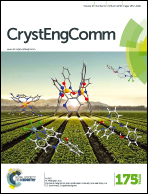A one-step nonaqueous sol–gel route to mixed-phase TiO2 with enhanced photocatalytic degradation of Rhodamine B under visible light†
Abstract
Anatase–rutile mixed-phase TiO2 is proved to have better photocatalytic activity than pure anatase TiO2, but the preparation of the mixed-phase TiO2 usually needs thermal treatments at more than 500 °C. In this study, we present a one-step nonaqueous sol–gel route to form mixed-phase TiO2 at relatively low temperatures from 160 to 220 °C. The structure, morphology and surface chemical state were examined with X-ray diffraction (XRD), transmission electron microscopy (TEM) and X-ray photoelectron spectroscopy (XPS), respectively. The influence of the preparation temperature on the structural characteristics including grain size and phase content were investigated using the Rietveld refinement. Through TEM, the evolution from sphere-like anatase nanoparticle to hexagonal rutile single-crystal was investigated. The photocatalytic activities of the obtained anatase and anatase-rutile TiO2 were evaluated by degradation of Rhodamine B under visible light, and a distinct enhanced activity was observed. Through the UV-vis spectrum and mass spectrum, the pathway of RhB degradation caused by the mixed-phase TiO2 with visible light was studied. At the same time, the mechanism of the enhanced photocatalytic properties was presented. The mechanisms were verified with UV-vis measurements. It is believed that the obtained mixed-phase TiO2 is one promising candidate for wastewater treatment.


 Please wait while we load your content...
Please wait while we load your content...